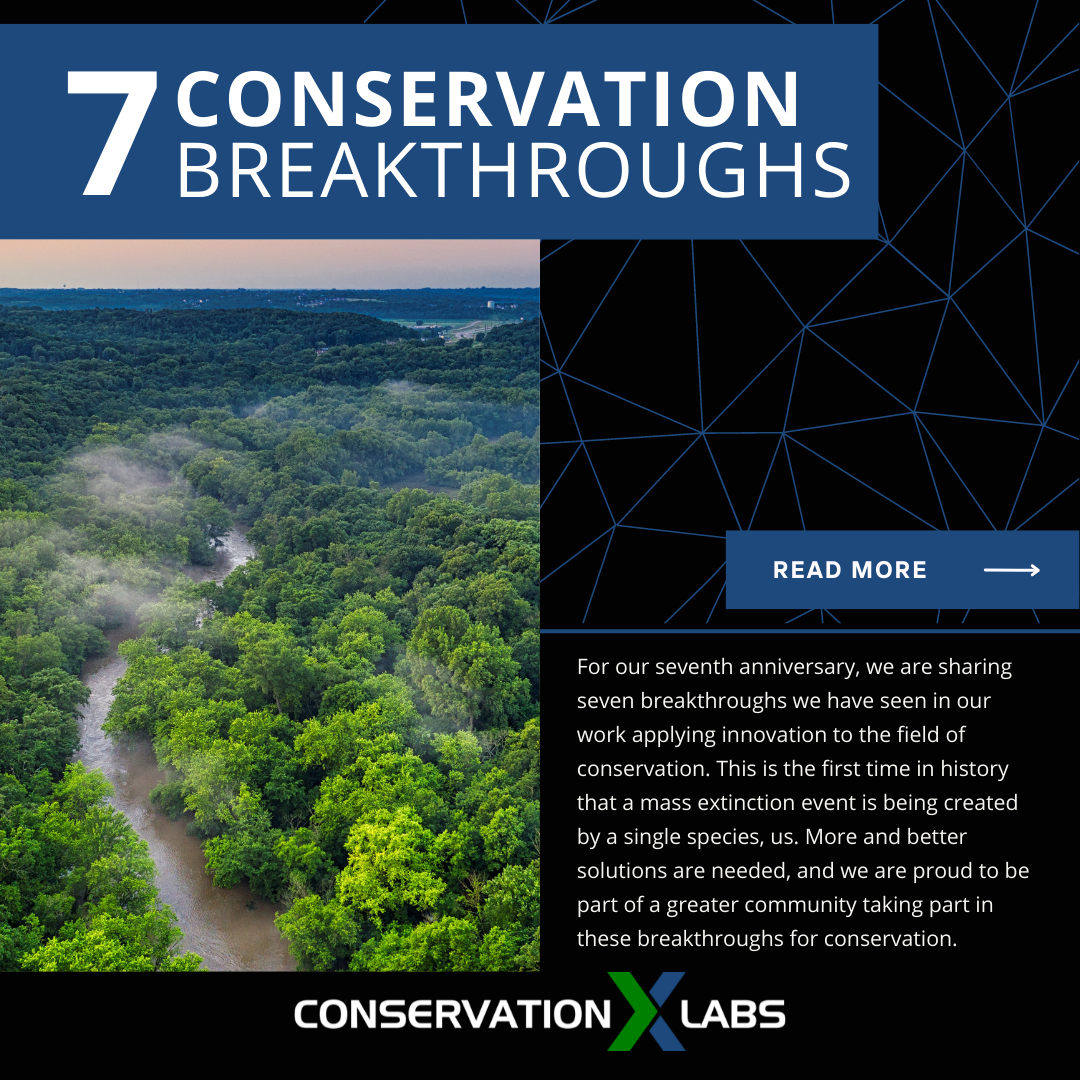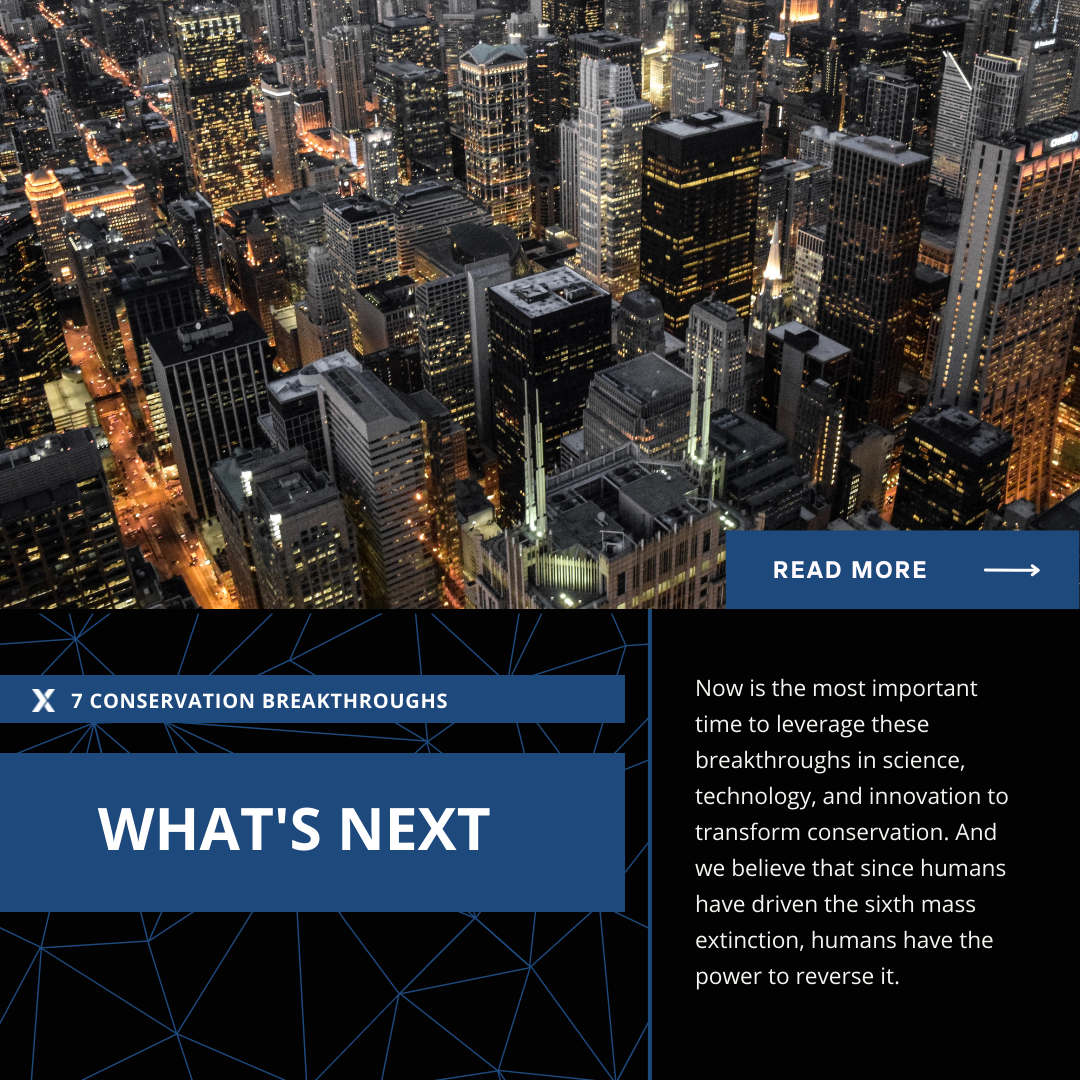Celebrating 7 conservation breakthroughs for our 7th anniversary
For CXL’s 7th anniversary, we are sharing 7 breakthroughs we have seen in our work in conservation innovation. During these seven years, global headlines warned that nature is declining at unprecedented rates and we may already be entering the sixth mass extinction. This is the first time in history that a mass extinction event is being created by a single species, us. More and better solutions are needed, and we are proud to be part of a greater community taking part in these critical and impactful conservation breakthroughs.
Over the last 7 years, Conservation X Labs had significant achievements in service of preventing the sixth mass extinction including:
Building 216 strong and impactful partnerships over 19 initiatives
Supporting 121 innovative conservation solutions with over $7.5M since 2017
Developing and supporting solutions in 8 critical extinction impact areas
Working with partners, innovators, companies and organizations in 67 countries on 6 continents
Follow on investment for some innovators at a collective $17,959,326 to support their solutions
A pillar of CXL’s work is that extinction is our only competitor meaning that ideas and innovation can come from anywhere and we must work together to change how we are thinking about our planet including conservationists, engineers, biologists, investors and industry leaders. These 7 conservation breakthroughs are just the beginning of a long-overdue shift to protect our planet and prevent extinction.
Shifting to solutions-focused approaches
Conservation as we know it is not succeeding fast enough. In order to match the speed and scale of the extinction crisis, we must shift conservation from a descriptive, discovery-based science focused on cataloging the demise of species to a global effort that engineers and deploys impactful solutions that address the underlying drivers of extinction.
There have been many exciting advancements in this space, from Project Drawdown’s list of climate solutions to the IUCN’s Green Status of Species optimistic vision of species recovery, and the Institute of Transformative Technology’s list of “50 Breakthroughs” which explore the technologies required to achieve the SDGs by 2030.
We are excited to work with Project Drawdown, the IUCN Green Status of Species, researchers at University of Oxford, and Re:wild, to create a new program that will rank the most impactful solutions to protect biodiversity and prevent extinctions.
2. Using prizes and challenges to advance impactful solutions
Prizes and challenges have a long history, since at least 1795, when Napoleon’s Food Preservation Prize led to the invention of canning. But it’s only recently that we’ve begun leveraging this approach to incentivize innovation to advance solutions that are changing entire markets, industries, and systems of living – from the clothes we wear to the food we eat.
We’re excited to see more prizes and challenges being used for conservation solutions. Recently, Prince William’s Earthshot Prize made a huge impact (we interviewed winner Kevin Kung on this episode of the Xploring podcast), our partners at Biomimicry Institute host the Ray of Hope Prize to accelerate nature-based startups; and Hackaday’s 2022 Prize centers on sustainability, resiliency, and circularity.
Our Grand Challenges look for anyone, anywhere to find solutions to the world’s toughest problems. We’ve had breakthrough success expanding our reach by building out a team in LATAM, and we’ve supported hundreds of breakthrough innovations through our global prizes and challenges, some of which are highlighted in our Innovation Catalog.
3. Democratizing AI technology to protect biodiversity
Exponential advances in computer vision and machine learning means that using AI for conservation is becoming more accessible than ever. This complex, but powerful technology promises to make conservationists' lives easier, and their work more efficient across the world.
In this field, we have seen huge leaps in democratization since Microsoft made the initial AI algorithm for animal object detection (classification + bounded box location) with Megadetector. There have also been breakthroughs in the democratization of AI through citizen science, identification apps, and platforms like WildMe and Wildlife Insights - where anyone can upload their images for identification. In 2021, the first-ever report on the State of Conservation Technology outlined a few areas where there is still huge potential for impact.
Our work developing the Sentinel democratizes access to advanced AI tech by allowing users to create, run, and deploy algorithms with little or no technical expertise. Learn how the Sentinel upgrades wildlife monitoring tools — like trail cameras and acoustic recorders — with revolutionary and intuitive AI technology through this video documenting the deployment of this device to monitor and protect endangered species in Costa Rica with Osa Conservation.
4. Transforming genetic intelligence in the field
Genetic analysis is not always available in the places where it is most needed: in the field. People and organizations don’t always have the time, money, or resources to use highly technical molecular processes that are needed for actionable decision making. By harnessing the power of low cost electronics, frugal engineering, and customized genetic analysis, breakthroughs in genetic intelligence will allow almost anyone to support conservation efforts in the field.
As the cost of genomic sequencing is dropping, the number of available DNA barcode sequences has expanded into the millions. While there is still a long way to go to capture all genetic biodiversity on Earth (with help from the International Barcode of Life), we have the start of a reference library that will make identifying an unknown sample in real-time possible. Recent advances that can target single nucleotides (CRISPR) allow us to go one step further by identifying populations - such as endangered salmon - subspecies, or specific strains and mutations of pathogens.
Creating innovations that apply genetic knowledge to conservation efforts is increasingly possible. The NABIT is an example of how we are leveraging this breakthrough to combat the threat of extinction with greater speed than ever before. The NABIT will give anyone the ability to quickly and easily identify an endangered species, a mislabeled fish, an invasive species, or a crop pest; making this a critical tool to protect planetary health.
5. Expanding who is involved in developing solutions
There are many worthwhile initiatives to make conservation, a historically exclusive field, more inclusive and supportive of all species on Earth. While the people closest to the issues are typically the ones who bear the greatest costs, they also have an important role to play in bringing knowledge and perspective to develop and inform innovation for conservation.
Over the past few years, we’ve learned a lot about the intersection of racism, inequity, and environmentalism from new voices in the space including Leah Thomas’ Why Every Environmentalist Should Be Anti-Racist and Audrey Cho’s Microfiber Pollution is an Environmental Justice Issue. There are also groups like Black AF in STEM and Black Mammologists who are leading the way to support, uplift, and amplify Black contributions to conservation and science.
We are committed to continue expanding who is involved in developing solutions through our programming, including through our open online project platform, the Digital Makerspace; encouraging global talent and experience in our prizes and challenges; highlighting diverse perspectives in our Voices of ASGM blog; and advancing diversity, equity, and inclusion in our organization.
6. Reinventing education to train the next generation of conservationists
Students want to do purpose-driven work to affect concrete, real-world change in the face of urgent and critical issues. Today’s leading institutions are embracing interdisciplinary work and experiential learning to engage the next generation of conservationists and give them the best tools to solve global planetary health issues like climate change and the biodiversity crisis.
We’re inspired by the work being done by institutions like ASU and Conservation Nation, developing interdisciplinary programming that values innovation and collaboration between scientists, technologists, storytellers, and entrepreneurs. Organizations like World Ocean Day and EarthEcho are amplifying, activating, and engaging youth to contribute to solutions for the frontlines of ocean conservation.
Our work in education has spanned from the Conservation Futures Toolkit, where we are providing tools for instructors to teach students in a way that encourages them to take action, embrace an entrepreneurial mindset, and ‘dare mighty things’; we have also embraced experimentation and learning in our approaches, working with Carnegie Mellon University, William & Mary, Duke, and other universities to advance the science of innovation.
7. Partnering across the public and private sectors to bring solutions to scale
For innovations to have real impact, conservation can’t operate alone and we believe that extinction is our only competitor. Strong partnerships between government agencies, investors, academia, nonprofits, brands, foundations and corporations are needed to create lasting impact.
There are many impressive examples of breakthrough partnerships leveraging social and environmental impact, including initiatives like 1% for the Planet.
Many of CXL’s programs leveraged partnerships to bring technologies to market: the Microfiber Innovation Challenge, where finalists are connecting with our brand partners including Under Armour and others in their textile supply chain; the Global Cooling Prize, which brought together numerous philanthropies, corporations, non-profits, and funding from the Government of India to incentivize and implement climate-friendly air conditioners; Oceans X Labs, which leveraged funding from WWF and the Australian government to identify aquaculture feed replacements; and the Amazon CoLab, utilizes funds from the US Government, Esri, and Microsoft to develop and test technologies in the field that improve the social and environmental outcomes from artisanal and small-scale gold mining.
What's next
Now is the most important time to leverage these breakthroughs in science, technology, and innovation to transform conservation. And we believe that since humans have driven the sixth mass extinction, humans have the power to reverse it. We can build the knowledge, capacity, and innovation needed to transform into a healthier and more sustainable world. These bold initiatives, backed with dedicated funding and strong participation from the private sector, will create opportunities for a collision of ideas and perspectives and open up pathways for imagination and ingenuity. To prevent the sixth mass extinction, we must embrace these 7 breakthroughs, and encourage even more breakthroughs for conservation in the future.














